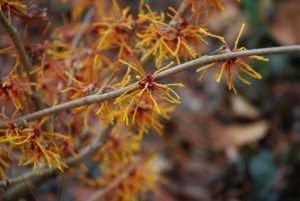Witchhazels (Hamamelis spp.) are medium to large shrubs which can be shaped into small trees by judicious pruning. In general, all witchhazels grow in full sun but can prosper with moderate amounts of shade. Other than pruning, they require little extra care. Plant in any soil type as long as it is adequately drained and mildly acidic.
Species native to the Eastern United States include American witchhazel (H. virginiana) and vernal witchhazel (H. vernalis). Asian species include Chinese witchhazel (H. mollis), Japanese witchhazel (H. japonica), and hybrid forms (H. x intermedia). The witchhazel flower color palette ranges from pale yellow, deep gold, copper, and purplish red.
In calendar order, first to flower is Vernal witchhazel (USDA hardiness zone 4). Vernal is a densely branched 8 to 12 foot shrub which blooms from early to mid-winter. Usually, flowering follows a short warm period. Small ½ inch wide yellow flowers, flushed red at the base, emit a pleasant witchhazel aroma.
The Asian witchhazels follow from mid-February thru most of March. Flowers of many new cultivars are larger and brighter colored. Among witchhazels the Asian forms present the widest flower color palette and have increased in popularity as a group
American witchhazel is the last to bloom in October and November in Southern Appalachian region (USDA hardiness zones 6 and 7). This witchhazel grows tall and is frequently pruned into an 18-25 foot tree.
All witchhazels turn pale yellow to dark golden foliage colors in autumn.


 Posted in
Posted in 
